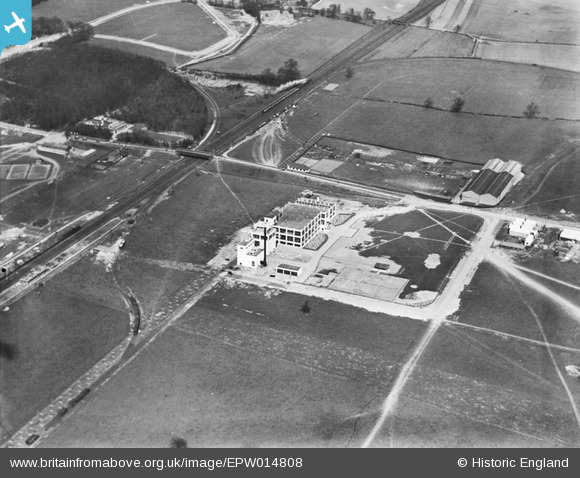EPW014808 ENGLAND (1926). The Shredded Wheat Factory, Welwyn Garden City, 1926
© Copyright OpenStreetMap contributors and licensed by the OpenStreetMap Foundation. 2025. Cartography is licensed as CC BY-SA.
Nearby Images (28)
Details
| Title | [EPW014808] The Shredded Wheat Factory, Welwyn Garden City, 1926 |
| Reference | EPW014808 |
| Date | 24-March-1926 |
| Link | |
| Place name | WELWYN GARDEN CITY |
| Parish | |
| District | |
| Country | ENGLAND |
| Easting / Northing | 524154, 212942 |
| Longitude / Latitude | -0.1992429016235, 51.800872723705 |
| National Grid Reference | TL242129 |
Pins

John W |
Wednesday 22nd of March 2017 10:55:28 PM | |

Paul |
Friday 31st of October 2014 12:37:40 AM | |

Paul |
Friday 31st of October 2014 12:37:15 AM | |

jimbo20 |
Sunday 19th of January 2014 09:49:52 PM | |

Nick G |
Sunday 20th of October 2013 07:52:41 PM | |

Howie |
Saturday 26th of January 2013 06:19:23 AM | |
Waitrose |

Nick G |
Sunday 20th of October 2013 06:58:15 PM |

Howie |
Saturday 26th of January 2013 06:17:42 AM | |

MB |
Tuesday 25th of September 2012 02:51:21 PM | |

MB |
Tuesday 25th of September 2012 02:49:21 PM | |

MB |
Tuesday 25th of September 2012 02:48:11 PM | |

MB |
Tuesday 25th of September 2012 02:47:39 PM | |

MB |
Tuesday 25th of September 2012 02:45:53 PM | |

MB |
Tuesday 25th of September 2012 02:44:33 PM | |
Opened in September 1926. |

John W |
Wednesday 22nd of March 2017 10:51:01 PM |

MB |
Tuesday 25th of September 2012 02:43:51 PM | |
Opened 1920, closed September 1926 when the new station opened. See http://www.disused-stations.org.uk/w/welwyn_garden_city_halt/index.shtml for more information about this temporary station. There was a smaller platform serving the Hertford branch for the same time period and for the same purpose opposite this platform. |

John W |
Wednesday 22nd of March 2017 10:53:14 PM |

MB |
Tuesday 25th of September 2012 02:42:28 PM | |

MB |
Tuesday 25th of September 2012 02:41:47 PM | |

MB |
Tuesday 25th of September 2012 02:39:55 PM | |

MB |
Tuesday 25th of September 2012 02:37:11 PM | |

MB |
Tuesday 25th of September 2012 02:33:24 PM | |

MB |
Tuesday 25th of September 2012 02:31:51 PM |
User Comment Contributions
The Shredded Wheat Factory from a train, Welwyn Garden City, 10/06/2014 |

Class31 |
Wednesday 11th of June 2014 04:41:48 PM |
This is another image that I find very interesting for this category... If you click on 'see image record', you will find that lots of people have already pinned the image, noting all the different industries that rapidly grew before the beginning of WW2 in this place - quite obviously after this image was taken! I do find the concept of Garden Cities generally quite interesting but don't personally know a lot about them - has anybody come across collection images of other planned cities across the country yet? |
Sandra Brauer |
Thursday 22nd of November 2012 08:57:23 AM |
There are a few of Letchworth like this one .. epw013190 |

BruceR |
Monday 5th of November 2012 10:13:38 PM |
Sir Ebenezer Howard (1850 –1928) is known for his publication Garden Cities of To-morrow (1898), the description of a utopian city in which people live harmoniously together with nature. This resulted in Welwyn and Letchworth garden cities near London. The ideas were also used in relation developments, such as Bournville by the Cadburys in Birmingham and the Rowntrees in York. I have annotated EPW001104 Bournville. The concept of the garden city is in contrast to the planned city. There are numerous examples of geometric developments in the Britain from Above collection, for example Billingham EPW032188. However, these do not always carry with them the philosophical approach to the relationship between those dwelling in the garden city and the landscape. For example, Cadbury insisted that the housing provided for workers in the chocolate factory should include a garden with an apple tree, thus encouraging a productive relationship with the land. Indeed, many of the Bournville’s houses might be described as cottages, reminiscent of those built on the more well-found English country estates from the shire countries. The garden city was attempting to bring the country to the town. |

Maurice |
Thursday 22nd of November 2012 08:57:23 AM |


![[EPW014808] The Shredded Wheat Factory, Welwyn Garden City, 1926](http://britainfromabove.org.uk/sites/all/libraries/aerofilms-images/public/100x100/EPW/014/EPW014808.jpg)
![[EPW014809] The Shredded Wheat Factory, Welwyn Garden City, 1926](http://britainfromabove.org.uk/sites/all/libraries/aerofilms-images/public/100x100/EPW/014/EPW014809.jpg)
![[EPW014807] The Shredded Wheat Factory, Welwyn Garden City, 1926](http://britainfromabove.org.uk/sites/all/libraries/aerofilms-images/public/100x100/EPW/014/EPW014807.jpg)
![[EPW054507] The Shredded Wheat Cereal Manufactory, Welwyn Garden City, 1937](http://britainfromabove.org.uk/sites/all/libraries/aerofilms-images/public/100x100/EPW/054/EPW054507.jpg)
![[EAW053104] The Shredded Wheat Factory, Welwyn Garden City, 1954](http://britainfromabove.org.uk/sites/all/libraries/aerofilms-images/public/100x100/EAW/053/EAW053104.jpg)
![[EAW053109] The Shredded Wheat Factory, Welwyn Garden City, 1954](http://britainfromabove.org.uk/sites/all/libraries/aerofilms-images/public/100x100/EAW/053/EAW053109.jpg)
![[EPW025533] The Shredded Wheat factory, Welwyn Garden City, 1928](http://britainfromabove.org.uk/sites/all/libraries/aerofilms-images/public/100x100/EPW/025/EPW025533.jpg)
![[EAW053083] The Shredded Wheat Factory, Welwyn Garden City, 1954](http://britainfromabove.org.uk/sites/all/libraries/aerofilms-images/public/100x100/EAW/053/EAW053083.jpg)
![[EPW054525] The Railway Station, the Shredded Wheat Cereal Manufactory and the surrounding industrial area, Welwyn Garden City, 1937](http://britainfromabove.org.uk/sites/all/libraries/aerofilms-images/public/100x100/EPW/054/EPW054525.jpg)
![[EPW022032] Shredded Wheat Factory and Sectional Factories, Welwyn Garden City, 1928](http://britainfromabove.org.uk/sites/all/libraries/aerofilms-images/public/100x100/EPW/022/EPW022032.jpg)
![[EPW022022] Archibald D Dawnay & Sons Ltd Constructional Engineering Works, Welwyn Garden City, 1928](http://britainfromabove.org.uk/sites/all/libraries/aerofilms-images/public/100x100/EPW/022/EPW022022.jpg)
![[EPW054519] The Shredded Wheat Cereal Manufactory, the Murphy Radio Ltd Manufactory and the Norton Grinding Wheel Co Manufactory, Welwyn Garden City, 1937. This image has been affected by flare.](http://britainfromabove.org.uk/sites/all/libraries/aerofilms-images/public/100x100/EPW/054/EPW054519.jpg)
![[EPW062053] Broadwater Road and environs, Welwyn Garden City, 1939](http://britainfromabove.org.uk/sites/all/libraries/aerofilms-images/public/100x100/EPW/062/EPW062053.jpg)
![[EPW025374] British International Films Studio and the Shredded Wheat Company Works, Welwyn Garden City, 1928](http://britainfromabove.org.uk/sites/all/libraries/aerofilms-images/public/100x100/EPW/025/EPW025374.jpg)
![[EPW054516] The Dawnays Limited Engineering Works and surrounding industrial units, Welwyn Garden City, 1937](http://britainfromabove.org.uk/sites/all/libraries/aerofilms-images/public/100x100/EPW/054/EPW054516.jpg)
![[EPW054515] The Welwyn Film Studios and the surrounding industrial area, Welwyn Garden City, 1937](http://britainfromabove.org.uk/sites/all/libraries/aerofilms-images/public/100x100/EPW/054/EPW054515.jpg)
![[EPW022021] British Instructional Films Studio, Welwyn Garden City, 1928](http://britainfromabove.org.uk/sites/all/libraries/aerofilms-images/public/100x100/EPW/022/EPW022021.jpg)
![[EPW022031] British Instructional Films Studio under construction, Welwyn Garden City, 1928](http://britainfromabove.org.uk/sites/all/libraries/aerofilms-images/public/100x100/EPW/022/EPW022031.jpg)
![[EPW054517] The Dawnays Limited Engineering Works and surrounding industrial units, Welwyn Garden City, 1937](http://britainfromabove.org.uk/sites/all/libraries/aerofilms-images/public/100x100/EPW/054/EPW054517.jpg)
![[EPW054500] The Murphy Radio Ltd Manufactory, the Sectional Factory Units and the Norton Grinding Wheel Co Manufactory, Welwyn Garden City, 1937](http://britainfromabove.org.uk/sites/all/libraries/aerofilms-images/public/100x100/EPW/054/EPW054500.jpg)
![[EPW054536] The Dawnays Limited Engineering Works and the Nivea Chemical Manufactory, Welwyn Garden City, 1937](http://britainfromabove.org.uk/sites/all/libraries/aerofilms-images/public/100x100/EPW/054/EPW054536.jpg)
![[EPW022033] The British Instructional Films Studio under construction, Welwyn Garden City, 1928](http://britainfromabove.org.uk/sites/all/libraries/aerofilms-images/public/100x100/EPW/022/EPW022033.jpg)
![[EPW025532] The British Instructional Films Studio, Welwyn Garden City, 1928](http://britainfromabove.org.uk/sites/all/libraries/aerofilms-images/public/100x100/EPW/025/EPW025532.jpg)
![[EPW025535] The British Instructional Films Studio, Welwyn Garden City, 1928](http://britainfromabove.org.uk/sites/all/libraries/aerofilms-images/public/100x100/EPW/025/EPW025535.jpg)
![[EPW054511] The Industrial Area, Welwyn Garden City, 1937](http://britainfromabove.org.uk/sites/all/libraries/aerofilms-images/public/100x100/EPW/054/EPW054511.jpg)
![[EPW054535] The Welwyn Film Studios, Welwyn Garden City, 1937](http://britainfromabove.org.uk/sites/all/libraries/aerofilms-images/public/100x100/EPW/054/EPW054535.jpg)
![[EPW047354] The Shredded Wheat Factory and other industrial works, Welwyn Garden City, 1935](http://britainfromabove.org.uk/sites/all/libraries/aerofilms-images/public/100x100/EPW/047/EPW047354.jpg)
![[EPW047352] The Shredded Wheat Factory and other industrial works near Broadwater Road, Welwyn Garden City, 1935](http://britainfromabove.org.uk/sites/all/libraries/aerofilms-images/public/100x100/EPW/047/EPW047352.jpg)
